 W
WAt the Window is an 1881 painting by the Norwegian Realism painter, Hans Heyerdahl, which is held in the collection of the National Gallery, Norway.
 W
WDawn, also known as the Girl with a Lily is an oil painting by the French artist William-Adolphe Bouguereau. It was one of his most notable works. Its dimensions are 214.9 × 107 cm.
 W
WAuguste Renoir painted two very similar versions of Blonde Bather in 1881 and 1882 – both are now in private collections but on public display. The model was Aline Charigot, later to become Renoir's wife. Influenced by seeing renaissance painting in Italy in 1881, these pictures showed a marked change of style from Renoir's previous work. Some commentators consider these are works of great beauty, others that they are vulgar. There has been criticism of the conservation work performed on the 1881 painting.
 W
WA Balcony in Paris is an oil on canvas painting by the French Impressionist painter Gustave Caillebotte. It was completed ca. 1880–81. The dimensions of the painting are 55.2 by 39 centimeters. It is housed in a private collection.
 W
WAuguste Renoir painted two very similar versions of Blonde Bather in 1881 and 1882 – both are now in private collections but on public display. The model was Aline Charigot, later to become Renoir's wife. Influenced by seeing renaissance painting in Italy in 1881, these pictures showed a marked change of style from Renoir's previous work. Some commentators consider these are works of great beauty, others that they are vulgar. There has been criticism of the conservation work performed on the 1881 painting.
 W
WAuguste Renoir painted two very similar versions of Blonde Bather in 1881 and 1882 – both are now in private collections but on public display. The model was Aline Charigot, later to become Renoir's wife. Influenced by seeing renaissance painting in Italy in 1881, these pictures showed a marked change of style from Renoir's previous work. Some commentators consider these are works of great beauty, others that they are vulgar. There has been criticism of the conservation work performed on the 1881 painting.
 W
WBoy Cutting Grass with a Sickle is a watercolor painting created in 1881 by Vincent van Gogh. It is owned by the Kröller-Müller Museum.
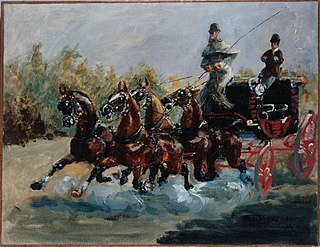 W
WCount Alphonse de Toulouse-Lautrec Driving His Mail-Coach is a painting by Henri de Toulouse-Lautrec of his father, a great lover of horses recognisable by his beard, completed in 1881 at the age of only 17 years. It is now in the Petit Palais in Paris.
 W
WDead Eagle Owl is an 1881 oil-on-canvas painting by Édouard Manet. One of the very few hunting still lifes in Manet's oeuvre, it depicts a dead Eurasian eagle-owl hanging upside down on a board as a hunting trophy. Dead Eagle Owl is one of a series of comparable still lifes that Manet painted in the same year in Versailles, during his recuperation from a serious illness. There are precedents for this morbid work in French still-life painting of the 18th century and Dutch still-life painting of the 17th century. The painting is in the collection of the Foundation E.G. Bührle in Zürich.
 W
WThe Death of Cleopatra, also known simply as Cleopatra, is an 1881 painting made by the Filipino painter Juan Luna. The painting was a silver medalist or second prize winner during the 1881 National Exposition of Fine Arts in Madrid. The 1881 Madrid painting contest was Luna's first art exposition. Because of the exposure, Luna received a pension scholarship at the Ayuntamiento de Manila. After the painting competition, Luna sold it for 5,000 Spanish pesetas, the highest price for a painting at the time. As Luna's "graduation work", The Death of Cleopatra was acquired by the Spanish government for one thousand duros.
 W
WDr Pozzi at Home is an 1881 oil painting by the American artist John Singer Sargent. The portrait of the French gynaecologist and art collector Samuel Jean de Pozzi was Sargent's first large portrait of a male subject: it measures 201.6 cm × 102.2 cm. It was the first work that Sargent exhibited at the Royal Academy in London. It was acquired by Armand Hammer in 1967, and has been held by the Hammer Museum in Los Angeles since 1991.
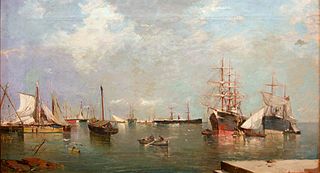 W
WHarbour or Seascape is a small 1881 oil on canvas painting by Joaquín Sorolla, early in his career. It is now in the Sorolla Museum in Madrid
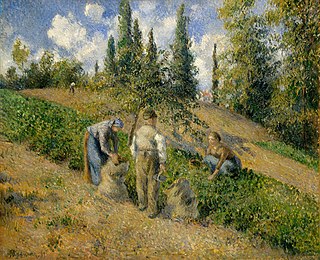 W
WThe Harvest, Pontoise is a late 19th-century painting by Dano-French artist Camille Pissarro. Done in oil on canvas, the work depicts a group of French farmers gathering potatoes; such subject material was a common theme used by Pissarro. The painting is in the collection of the Metropolitan Museum of Art.
 W
WThe Last Sleep of Arthur in Avalon is a painting by Edward Burne-Jones, started in 1881. The massive painting measures 279 cm × 650 cm, and is widely considered to be Burne-Jones's magnum opus.
 W
WLuncheon of the Boating Party is a painting by French impressionist Pierre-Auguste Renoir. Included in the Seventh Impressionist Exhibition in 1882, it was identified as the best painting in the show by three critics. It was purchased from the artist by the dealer-patron Paul Durand-Ruel and bought in 1923 from his son by industrialist Duncan Phillips, who spent a decade in pursuit of the work. It is now in The Phillips Collection in Washington, D.C. It shows a richness of form, a fluidity of brush stroke, and a flickering light.
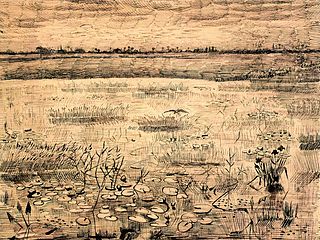 W
WMarsh with Water Lilies is a drawing by Vincent van Gogh. It was executed at Etten in June 1881.
 W
WThe Morning of the Streltsy Execution is a painting by Vasily Ivanovich Surikov, painted in 1881. It illustrates the public execution after the Streltsy's failed attempted uprising before the walls of the Kremlin. It shows the display of power the Russian government had during the late years of the 17th century.
 W
WPanorama Mesdag is a panorama by Hendrik Willem Mesdag. Housed in a purpose-built museum in The Hague, the panorama is a cylindrical painting more than 14 metres high and about 40 metres in diameter. From an observation gallery in the centre of the room the cylindrical perspective creates the illusion that the viewer is on a high sand dune overlooking the sea, beaches and village of Scheveningen in the late 19th century. A foreground of fake terrain around the viewing gallery hides the base of the painting and makes the illusion more convincing.
 W
WPeasant Character Studies is a series of works that Vincent van Gogh made between 1881 and 1885.
 W
WAlice and Elisabeth Cahen d’Anvers is an oil painting by French impressionist Pierre-Auguste Renoir. Produced in Paris in 1881, the painting depicts the sisters Alice and Elisabeth, daughters of Louise Cahen d'Anvers and her husband the Jewish banker Louis Raphaël Cahen d'Anvers. It is considered one of the most popular works in the collection of the São Paulo Museum of Art, where it has been conserved since 1952.
 W
WPortrait of Lady Meux is a name given to several full-length portraits by James Abbott McNeill Whistler. Valerie Susan Meux, née Langdon, was a Victorian socialite and the wife of the London brewer, Sir Henry Meux. She claimed to have been an actress, but was apparently on the stage for only a single season. She is believed to have met Sir Henry at the Casino de Venise in Holborn, where she worked as a banjo-playing barmaid and prostitute under the name Val Reece.
 W
WPortrait of Monsieur Pertuiset the Lion-Hunter is an 1881 oil on canvas painting by Édouard Manet, produced just before his death and now in the São Paulo Art Museum. It shows the French explorer and adventurer Eugène Pertuiset, who in 1873 discovered the northern part of Tierra del Fuego in Patagonia whilst searching for Inca remains, an aim he was distracted from by discovering gold. He unsuccessfully petitioned the French authorities to buy land in Tierra del Fuego and on Dawson Island.
 W
WThe Portrait of Richard Gallo is an oil on canvas painting by French painter Gustave Caillebotte in the Nelson-Atkins Museum of Art, Kansas City, Missouri. The painting measures 97 × 116 cm. and dates from 1881, and is part of a series of seven portraits of Richard Gallo, one of the best childhood friends of the artist, composed between 1878 and 1884."This series demonstrates with great artistic coherence how personal contribution of the artist to express an impressionistic point of view on the modern world".
 W
WThe Rabbit is an 1881 oil painting by the French artist Édouard Manet, now displayed at the National Museum Wales in Cardiff, Wales. The work is a still life featuring a hung rabbit or hare which has been placed on a hook outside a closed house window.
 W
WRochefort's Escape is a painting by Édouard Manet painted in around 1881, currently in the Kunsthaus Zürich. It depicts the 1874 escape of Victor Henri Rochefort, Marquis de Rochefort-Luçay from captivity in New Caledonia to which he had been sentenced for his role in the Paris Commune. The genre of history painting traditionally dealt with historic and mythological topics, and Rochefort's Escape is considered highly significant for its depiction of an event still fresh in public memory. A second smaller version of the painting is in the Musée d'Orsay.
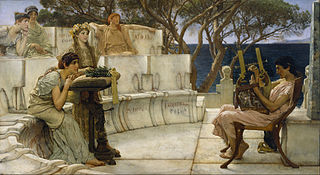 W
WSappho and Alcaeus is an 1881 oil painting by Lawrence Alma-Tadema. It is held by the Walters Art Museum in Baltimore.
 W
WScotland Forever! is an 1881 oil painting by Lady Butler depicting the start of the charge of the Royal Scots Greys, a British cavalry regiment that charged alongside the British heavy cavalry at the Battle of Waterloo in 1815. The painting has been reproduced many times and is considered an iconic representation of the battle itself, and of heroism more generally.
 W
WThe Small Meadows in Spring, By is an 1881 painting by Alfred Sisley, on loan from Tate Britain to the National Gallery since 1997.
 W
WSpring is a painting by Édouard Manet that was created in 1881. It debuted at the Paris Salon of 1882 and was considered the greatest and final public success of Manet's Salon career. It depicts Parisian actress Jeanne DeMarsy in a floral dress with parasol and bonnet against a background of lush foliage and blue sky, as the embodiment of Spring. The painting also became the first work of art ever to be published in color.
 W
WStill Life with Beer Mug and Fruit is an oil painting created in September 1881.
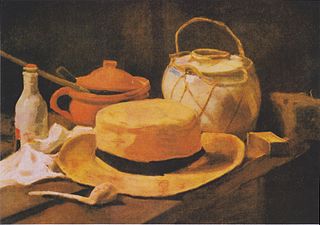 W
WStill Life with Straw Hat also known as Still Life with Yellow Straw Hat and Still Life with Hat and Pipe was painted by Vincent van Gogh in late November - mid-December 1881 or possibly in 1885 in the town of Nuenen.
 W
WA Street in Brittany is a painting dated 1881 by the artist Stanhope Forbes.
 W
WLe Suicidé is a small oil painting by Édouard Manet, completed between 1877 and 1881. The painting has been little studied within Manet's oeuvre, as art historians have had difficulty finding a place for the work within the development of Manet's art.
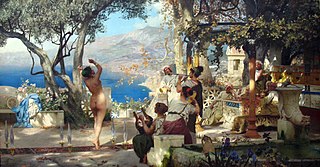 W
WThe Sword Dance is an 1881 painting by the Polish painter Henryk Siemiradzki. It is also known as Dance Amongst Daggers, Dance Amongst Swords and similar variations. It depicts a nude woman who dances between swords while a group of women play music and a few men watch. The setting is Italian and there have been several interpretations of what exactly the painting depicts.
 W
WThe Thin Red Line is an 1881 oil-on-canvas painting by Robert Gibb depicting the 93rd Regiment of Foot at the Battle of Balaclava on 25 October 1854, during the Crimean War. In an incident which became known as "The Thin Red Line", a two-deep line of around 500 red-coated Scottish infantry from the Highland Brigade – with support from around 1,000 Royal Marines and Turkish infantry along with six guns of field artillery – stood firm against a force of around 2,500 Russian cavalrymen. The incident was a small one, in the context of the battle and the war as a whole, but became the focus for celebrating the stoicism and steadfastness of the British Army after Gibb's painting was exhibited.
 W
WThree Women in Church is an 1881 oil painting by the German realist painter Wilhelm Leibl which is in the collection of the Kunsthalle Hamburg.
 W
WTwo Sisters or On the Terrace is an 1881 oil-on-canvas painting by French artist Pierre-Auguste Renoir. The dimensions of the painting are 100.5 cm × 81 cm. The title Two Sisters was given to the painting by Renoir, and the title On the Terrace by its first owner Paul Durand-Ruel.
 W
WThe early works of Vincent van Gogh comprise a group of paintings and drawings that Vincent van Gogh made when he was 27 and 28, in 1881 and 1882, his first two years of serious artistic exploration. Over the course of the two-year period Van Gogh lived in several places. He left Brussels, where he had studied for about a year in 1881, to return to his parents’ home in Etten, where he made studies of some of the residents of the town. In January 1882 Van Gogh went to The Hague where he studied with his cousin-in-law Anton Mauve and set up a studio, funded by Mauve. During the ten years of Van Gogh's artistic career from 1881 to 1890 Vincent's brother Theo would be a continuing source of inspiration and financial support; his first financial support began in 1880 funding Vincent while he lived in Brussels.
 W
WThe Virgin with Angels, also known as The Song of the Angels is an oil painting by the French artist William-Adolphe Bouguereau. Its dimensions are 213.4 × 152.4 cm.